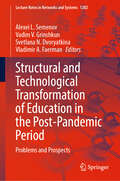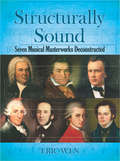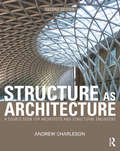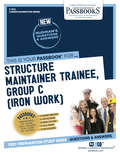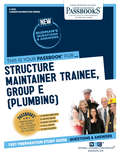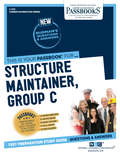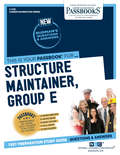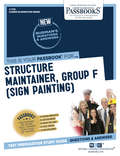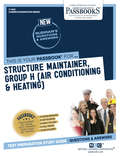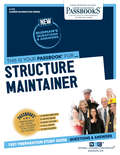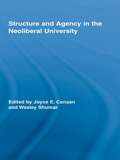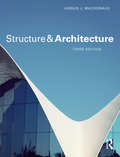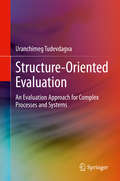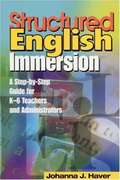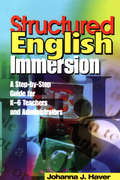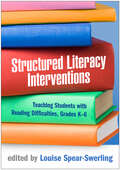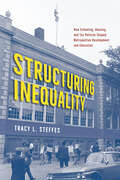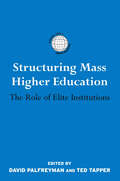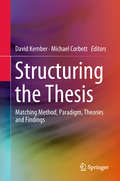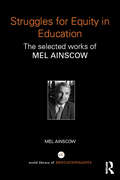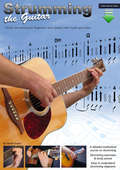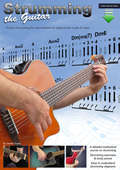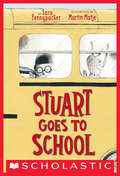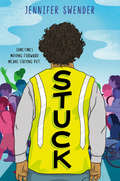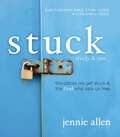- Table View
- List View
Structural and Technological Transformation of Education in the Post-Pandemic Period: Problems and Prospects (Lecture Notes in Networks and Systems #1282)
by Vladimir A. Faerman Alexei L. Semenov Svetlana N. Dvoryatkina Vadim V. GrinshkunCovering both pre-university and university levels, this book addresses the challenges and adaptations in mathematics education during the pandemic. The book "Structural and Technological Transformation of Education in the Post-Pandemic Period" critically examines the changes in STEM education, particularly in mathematics and computer science, prompted by the COVID-19 pandemic. It presents innovative methodologies that incorporate technology into teaching, highlighting the role of ICT in enhancing learning experiences. The focus is on hybrid intelligent systems and data-driven assessment methods that personalize learning and improve educational outcomes. Solutions discussed include the implementation of blended learning models, fostering critical thinking through complex tasks, and using historical contexts to deepen mathematical understanding. This edition serves as a valuable resource for educators, policymakers, and students aspiring to teach in STEM fields, providing insights into the evolving educational landscape.
Structurally Sound: Seven Musical Masterworks Deconstructed (Dover Books on Music)
by Eric WenMusic theorist Eric Wen presents in-depth analyses of seven masterworks from the common-practice period of Western art music:Bach: Air from Orchestral Suite No. 3 in D, BWV 1068 Mendelssohn: Andante con moto tranquillo from Piano Trio No. 1 in D minor, Op. 49 Schubert: Nacht und Traüme, D. 827 Haydn: Adagio — Vivace assai from Symphony No. 94 in G, Hob. I:94 Mozart: Molto Allegro from Symphony No. 40 in G minor, K. 550 Beethoven: Marcia funebre: Adagio assai from Symphony No. 3 in E-flat, Op. 55 Brahms: Un poco presto e con sentimento from Violin Sonata No. 3 in D minor, Op. 108Wen employs the analytic approach developed by Heinrich Schenker, a method that uses musical notation to clarify and illuminate a work's structural hierarchies. Copiously illustrated with analytic musical examples that elucidate the tonal organization of each of the seven works, this study also explores aspects of form, rhythmic organization, and programmatic meaning. This volume will be of particular interest to musicologists and professional musicians, and it will also appeal to listeners keen to probe the rich complexities of these masterpieces.
Structure As Architecture: A Source Book for Architects and Structural Engineers
by Andrew CharlesonStructure as Architecture presents a comprehensive analysis of the indispensable role of structure in architecture. An exploration, as well as a celebration, of structure, the book draws on a series of design studies and case study examples to illustrate how structure can be employed to realize a wide range of concepts in contemporary architecture. By examining design principles that relate to both architecture and structural engineering, Andrew Charleson provides new insights into the relationship between both the technical and aesthetic aspects of architecture. Now in its second edition, the text has been extensively revised and updated throughout. Features include: A brand new chapter on hidden structure, adding to the material on exposed structures Two new chapters on using structure to realise common architectural concepts through a combination of precedents and creative design Over 50 new case studies from across the globe Easy-to-understand diagrams and a highly visual design to aid understanding and accessibility More than two hundred case studies of contemporary buildings from countries such as the UK, the US, France, Germany, Spain, Hong Kong, Australia and Japan illustrate how a thorough integration of structure adds layers of richness and enhances the realisation of architectural design concepts.
Structure Maintainer Trainee, Group C: Passbooks Study Guide (Career Examination Series)
by National Learning CorporationThe Structure Maintainer Trainee, Group C (Iron Work) Passbook® prepares you for your test by allowing you to take practice exams in the subjects you need to study. It provides hundreds of questions and answers in the areas that will likely be covered on your upcoming exam, including but not limited to: Fundamentals of the sheet metal trade, including the proper selection, use and care of tools, material and equipment used in the sheet metal work; Reading and understanding technical drawings; Performing job-related arithmetic; Safe work practices; and more.
Structure Maintainer Trainee, Group E: Passbooks Study Guide (Career Examination Series)
by National Learning CorporationThe Structure Maintainer Trainee, Group E (Plumbing) Passbook® prepares you for your test by allowing you to take practice exams in the subjects you need to study. It provides hundreds of questions and answers in the areas that will likely be covered on your upcoming exam, including but not limited to: fundamentals of the plumbing trade, including the proper selection, use and care of tools, materials and equipment used in plumbing work; reading and understanding technical drawings; performing job-related arithmetic; safe work practices, including basic first-aid procedures; and more.
Structure Maintainer, Group C: Passbooks Study Guide (Career Examination Series #C-1776)
by National Learning CorporationThe Structure Maintainer, Group C (Iron Work) Passbook® prepares you for your test by allowing you to take practice exams in the subjects you need to study. It provides hundreds of questions and answers in the areas that will likely be covered on your upcoming exam, including but not limited to: fabricating and repairing structural and ornamental ironwork; operating machines and tools of the ironwork trade; burning, rigging and welding; reading sketches, drawings and prints; safety procedures; and more.
Structure Maintainer, Group E: Passbooks Study Guide (Career Examination Series)
by National Learning CorporationThe Structure Maintainer, Group E (Plumbing) Passbook® prepares you for your test by allowing you to take practice exams in the subjects you need to study. It provides hundreds of questions and answers in the areas that will likely be covered on your upcoming exam, including but not limited to: plumbing supplies and materials; proper and efficient use of tools; safe plumbing procedures and the plumbing code; reading and interpreting blueprints, schematics and technical drawings related to the plumbing trade; and more.
Structure Maintainer, Group F: Passbooks Study Guide (Career Examination Series #C-1776)
by National Learning CorporationThe Structure Maintainer, Group F (Sign Painting) Passbook® prepares you for your test by allowing you to take practice exams in the subjects you need to study. It provides hundreds of questions and answers in the areas that will likely be covered on your upcoming exam, including but not limited to: Select words and symbols for the design of effective signs; Ability to proportion letters and symbols on signs; Ability to use brushes and other equipment used in the production of freehand lettered signs; Knowledge of paints, brushes and other materials related to the various methods of production of signs; and more.
Structure Maintainer, Group H: Passbooks Study Guide (Career Examination Series)
by National Learning CorporationThe Structure Maintainer, Group H (Air Conditioning & Heating) Passbook® prepares you for your test by allowing you to take practice exams in the subjects you need to study. It provides hundreds of questions and answers in the areas that will likely be covered on your upcoming exam, including but not limited to: The maintenance, repair and overhaul of boilers and boiler sections, furnaces, air-conditioners, compressors, condensers, evaporators, fans, motors, electrical and electronic controls and valves, heaters, radiators, pumps and piping; Proper use of tools and equipment; Reading and interpreting sketches and drawings; Mathematical computations; and more.
Structure Maintainer: Passbooks Study Guide (Career Examination Series #C-1776)
by National Learning CorporationThe Structure Maintainer Passbook® prepares you for your test by allowing you to take practice exams in the subjects you need to study. It provides hundreds of questions and answers in the areas that will likely be covered on your upcoming exam.
Structure and Agency in the Neoliberal University (Routledge Research in Education)
by Wesley Shumar Joyce E. CanaanThis volume considers how current transitions in postsecondary education are impacting Higher Education (HE) institutions and subjects in a number of Northern nations, as well as how these transitions are indicative of the wider shift from the welfare to the market state. The university is now considered a key site for training and wealth generation in the so-called 'knowledge economy' that operates in a globalising, high tech world. Further, these transitions are underpinned by neo-liberal economic ideas that assume that the public sector is a drag on the economy unless it is subject to the rules, regulations and assumptions that govern the private sector. This excellent volume - an important contribution to Education as well as Economics and Politics - furthers our understandings of universities as marketable entities as part of the globalized economy.
Structure and Architecture
by Angus J. MacdonaldThis thoroughly updated edition of Angus J. Macdonald’s insightful book Structure and Architecture offers an in depth analysis of structural design and its relationship with architecture. It draws on clear explanations of the connections between structural form, structural performance and architectural design to explore the interface between the technical and the visual in architecture. Additional chapters in this new edition cover the fields of structural theory, structural philosophy, the contributions of prominent engineers to the evolution of Modern architecture, and the concept and practice of sustainable design. Fully illustrated, this critical appraisal of structures is a core-curriculum text for students of architecture, structural engineering and architectural history, and is also a valuable resource for practitioners of these disciplines.
Structure-Oriented Evaluation: An Evaluation Approach for Complex Processes and Systems
by Uranchimeg TudevdagvaThis book introduces a new branch of evaluation theory, where evaluation and score calculation is embedded into general measure theory, as is typical in geometry, probability theory and reliability theory. The author describes the theoretical background of new evaluation model for complex processes, where interests of involved groups are considered as multi-players of evaluation process. Readers will learn how the logical structure of a process/system can be included into an evaluation. The author applies these techniques not only to the visualization of evaluation goals, but also the designed logical structure becomes the basis for calculation of evaluation scores. Various examples are provides to demonstrate the implementation of the methods.
Structured English Immersion: A Step-by-Step Guide for K-6 Teachers and Administrators
by Johanna J. HaverPresents the theory that children learning another language succeed more easily when in the company of other children who are fluent in the new language.
Structured English Immersion: A Step-by-Step Guide for K-6 Teachers and Administrators
by Johanna J. HaverExperienced teacher and researcher Johanna Haver shows how easy it is to ensure that English Language Learners gain mastery of English, as well as learn the essentials of the mainstream curriculum.
Structured Literacy Interventions: Teaching Students with Reading Difficulties, Grades K-6 (The Guilford Series on Intensive Instruction)
by Louise Spear-SwerlingComprehensive and evidence-based, Structured Literacy (SL) approaches place a high value on explicit, systematic, and sequential instruction. This book brings together leading experts to present a wealth of SL interventions for different components of literacy. Chapters describe instructional strategies for supporting phonological awareness, basic and multisyllabic word decoding, spelling, reading fluency, vocabulary, oral and reading comprehension, and written expression, especially for at-risk readers and those with disabilities. Including case studies, sample intervention activities, lesson plans, and end-of-chapter application activities, the book contains reproducible tools that can be downloaded and printed in a convenient 8½&“ x 11&” size. An NCTQ Exemplary Text for Reading Instruction See also Louise Spear-Swerling's authored volume, The Structured Literacy Planner: Designing Interventions for Common Reading Difficulties, Grades 1–9, which provides blueprints for tailoring interventions based on a learner's reading profile.
Structuring Inequality: How Schooling, Housing, and Tax Policies Shaped Metropolitan Development and Education
by Tracy L. SteffesHow inequality was forged, fought over, and forgotten through public policy in metropolitan Chicago. As in many American metropolitan areas, inequality in Chicagoland is visible in its neighborhoods. These inequalities are not inevitable, however. They have been constructed and deepened by public policies around housing, schooling, taxation, and local governance, including hidden state government policies. In Structuring Inequality, historian Tracy L. Steffes shows how metropolitan inequality in Chicagoland was structured, contested, and naturalized over time even as reformers tried to change it through school desegregation, affordable housing, and property tax reform. While these efforts had modest successes in the city and the suburbs, reformers faced significant resistance and counter-mobilization from affluent suburbanites, real estate developers, and other defenders of the status quo who defended inequality and reshaped the policy conversation about it. Grounded in comprehensive archival research and policy analysis, Structuring Inequality examines the history of Chicagoland’s established systems of inequality and provides perspective on the inequality we live with today.
Structuring Mass Higher Education: The Role of Elite Institutions (International Studies in Higher Education)
by David Palfreyman Ted TapperUndoubtedly the most important development in higher education in recent years has been the seemingly inexorable expansion of national systems. In a comparatively short time period many countries have moved from an elite to a mass model. Furthermore, expansion has invariably changed the whole experience of higher education for all the interested parties from, presidents, rectors and vice-chancellors to first-term undergraduates. Structuring Mass Higher Education examines the impact of this change upon the existing national structures of higher education. It also defines and highlights what makes an ‘elite’ university – something which institutions must strive for in order to gain their position as global players. With case studies and contributions from a wide range of international authors, the book explores questions such as: Do higher education institutions retain a national significance, even though the vestiges of an international reputation have long faded? Has expansion undermined the quality of higher education because governments sought to expand "on the cheap"? Is the elite institutional response to mass higher education perceived as a threat to be responded to with purposeful action that sustains their elite status? Does the emergence of the international league tables pose a challenge to those responsible for governing elite institutions? These are critical issues with which both policy-makers and institutional leaders will have to grapple over the next ten years, making Structuring Mass Higher Education a timely, relevant, and much needed text. It will appeal to policy makers and practitioners within higher education as well as student and scholars worldwide.
Structuring the Thesis: Matching Method, Paradigm, Theories and Findings
by Michael Corbett David KemberThe book is a collective investigation of the structuring of theses in education, the social sciences and other disciplines that commonly do not follow the standard procedures of the scientific method. To help research students design a structure for their own thesis and liberate their investigations from the constraints associated with the use of the conventional structure, it explains how the structures adopted were designed to suit the topic, methodology and paradigm. It also provides a wide range of examples to draw upon, which suit a broad spectrum of theory, methodological approaches, research methods and paradigms. Additionally, by analyzing the methodologies and paradigms, and reviewing the methodological and paradigmatic spectrum, it offers a significant contribution to the way research is conceptualized.The book addresses a number of key questions faced by students, supervisors and examiners: •Why do examiners often find it difficult to read work in non-scientific disciplines when theses are structured in accordance with the conventional scientific method?•Why do students in non-scientific disciplines struggle to write up the outcomes of their research in the conventional structure?•What alternative thesis structures can be devised to better suit the wide range of methods?•Which theories and paradigms are commonly followed in education and the social sciences and how do these perspectives influence the research process? •What methods, theories and paradigms are commonly adopted by education and social science students and what problems do these pose when students write their theses?
Struggles for Equity in Education: The selected works of Mel Ainscow
by Mel AinscowIn the World Library of Educationalists series, international experts compile career-long collections of what they judge to be their finest pieces – extracts from books, key articles, salient research findings, major theoretical and practical contributions – so the world can read them in a single manageable volume. Readers will be able to follow the themes and strands and see how their work contributes to the development of the field. Spanning Mel Ainscow’s accomplished 30 year international career in education, the texts in this book trace his efforts to find ways of fostering more equitable forms of education. This has involved a series of struggles as he has experimented with different approaches - in a variety of contexts - to find new possibilities for responding to learner diversity. Over the years this has related to a variety of headline themes, starting from special education, through to integration, on to inclusive education, and then, more recently, educational equity. The readings have been chosen to illustrate the changes that have occurred in Ainscow’s thinking and practices and a short introduction is provided for each chapter that is intended to help readers to understand the significance of what is presented and how this relates to other chapters in the book. The writings in this text reinforce the idea that the promotion of equity in schools is essentially a social process that has to occur within particular contexts.
Strumming the Guitar: Guitar Strumming for Beginners and Upward with Audio and Video (Strumming the Guitar #1)
by Gareth EvansStrumming the Guitar Book 1 is a detailed course for beginners and upward, focusing solely on the subject of guitar strumming. Separate sections take on strumming, changing chords and coordinating chord changes while strumming, therefore maintaining a thorough approach throughout with components broken down at every level. With this incremental method, this guitar strumming book enables beginners to absorb everything important from the start and progress consistently as the difficulty level increases. Guitar Strumming Techniques - Before anything else, the basics of strumming are covered from the ground up, assisted with professional hand drawn illustrations. Learn how to hold the plectrum for strumming, how to strum chords that require you to miss certain strings, pre-emptive chord changing, open strums and more.Guitar Strumming Patterns - 70 different guitar strumming patterns that can be used throughout the book, all written with easy to understand, graphical, strumming diagrams. Rhythmical Notation - Understand the common language of music by becoming familiar with rhythmical notation. Learn whole notes, half notes, quarter notes, eighth notes, their equivalent rests, dotted notes, ties and the basics of time signatures. All shown with clear charts and diagrams.Chord Changes - Seven groups of chord changes, made up almost entirely of open chords. The book starts with the easiest chord changes in which fretting finger locations can be shared and works up to more difficult chord changes where fretting fingers need to relocate in independent directions.Strumming Exercises and Study Pieces - Every section includes strumming exercises that combine chord changes with strumming, each section concluding with a musical study piece using the skills learnt in styles of Slow Pop, Spanish style, Grunge and Country Pop. In total there are 85 strumming exercises and 10 musical study pieces, while more combinations can be found by selecting from the 70 given strumming patterns to use with them.Audio and Video - All exercises and musical study pieces are demonstrated with audio (downloadable 154 MB). All study pieces have a backing track for you to play over. Online videos (21 in total size of 775 MB) are also used to enhance explanations.Please Note: The eBook includes musical pieces so is not suitable for smaller screens.
Strumming the Guitar: Guitar Strumming for Intermediate & Upward with Audio & Video (Strumming the Guitar #2)
by Gareth EvansStrumming the Guitar Book 2 is a detailed course for intermediate level and upward focusing solely on the subject of guitar strumming. This book goes beyond the basics, covering power chords, strumming in 3/4 time, barre chords, swing feel, early chord changes, using a capo to change key, using a capo to avoid barre chords, muted strums and 16th note strumming in 4/4 time and 6/8 time. Throughout the book as the difficulty level progresses, separate sections take on strumming alone, changing chords alone and coordinating chord changes while strumming, therefore maintaining a thorough approach with components broken down at every level. Guitar Strumming Techniques - Advice is given on how to fret and strum power chords, barre chords (major, minor and dominant 7th) and how to refer to the root note to find them, using a capo and muted strumming. All with purpose made diagrams and professionally hand drawn illustrations. Guitar Strumming Patterns - 158 different guitar strumming patterns that can be used throughout the book, all written with easy to understand, graphical, strumming diagrams. These include 70 strumming patterns in 4/4 time, 22 strumming patterns in 3/4 time, 20 muted strumming patterns, 24 sixteenth note strumming patterns in 6/8 time and 22 sixteenth note strumming patterns in 4/4 time. Chord Changes - Over 100 chords are used to facilitate what the book teaches about strumming, divided into fourteen groups of chord changes. From simpler chords such as A major to more advanced ones such as A7sus2/G and lots more inbetween. Strumming Exercises and Study Pieces - Every section includes strumming exercises that combine chord changes with strumming, each section concluding with a musical study piece using the skills learnt in styles of Grunge, UK Modern Alternative, Jig, Waltz, Pop, Swing Jazz, Blues, Pop Ballad and Power Ballad. There are 70+ strumming exercises and 15 musical study pieces, while more combinations can be found by selecting from the 158 given strumming patterns to use with them. Audio and Video - All exercises and musical study pieces are demonstrated with audio (downloadable 149 MB). All study pieces have a backing audio track for you to play over. Online videos (7 in total size of 90.8 MB) are also used to enhance explanations. Please Note: The eBook includes musical pieces so is not suitable for smaller screens.
Stuart Goes to School
by Sara Pennypacker“[An] excellent sequel to Stuart’s Cape . . . Precocious readers looking for clever and unusual situations will not be disappointed. Hilarious.” —Kirkus Reviews (starred review)Our favorite worrier is back, and Stuart is about to start third grade. As he makes his way to the first day of school, wearing the worst outfit ever, what could a first-rate worrier do but worry?Stuart worries about getting stuck in the boys’ bathroom, about not having anything to show for show-and-tell, but most of all, about not making any friends. With his cape, though, Stuart is bound to have a day full of wacky adventures.“This humorous fantasy perfectly captures the child’s-eye view of elementary-school life . . . Young readers are sure to identify with Stuart’s persistent quest to find his place in the classroom society.” —School Library Journal“[A] wryly funny mix of the real and the magical, enhanced by Matje’s quirky line art.” —Publishers Weekly
Stuck
by Jennifer SwenderA coming-of-age story about a boy who is used to flying under the radar, and the classroom of kids determined to help him stand out. This touching friendship tale is the perfect read for fans of Fish in a Tree and Song for a Whale. <p><p> If Austin picked a color to describe his life, it would be tumbleweed brown. Austin doesn't like standing out. He’s always the new kid, and there's no hiding his size. Plus, Austin has a secret: he struggles to read. Then Austin meets Bertie, who is razzmatazz. Everything about Bertie is bursting! <p><p> But the best part of his newest school is the Safety Squad, with their laser lemon vests. Their easy confidence and leadership stand out in the coolest way. Even when things are not so vibrant and life at home makes Austin feel pacific blue, for the first time, he wants to leave a mark. And the more Austin speaks up, the more he finds he may not be that different after all.
Stuck Bible Study Guide plus Streaming Video, Updated Edition: The Places We Get Stuck and the God Who Sets Us Free
by Jennie AllenSo many of us live stuck. Stuck trying to seem perfect. Stuck in sadness. Stuck feeling numb. Stuck pursuing more stuff to make us happy. Stuck in something we can't even name. These stuck places often go unattended inside of us and they are shaping our lives more than we would like to think. We've been trying to fix this feeling with everything but . . .God. He has a plan for these spaces inside of us, the places we feel broken, but we have to go to Him. Stuck is a journey to take an honest look at the fight going on inside, leading us to the God who has a plan to restore it, to restore us.This study guide includes:Individual access to eight streaming video sessionsPersonal Bible studies and interactive projectsFull Leader's Guide with tips and resourcesHow to Find God personal salvation guideStreaming video access included. Access code subject to expiration after 12/31/2029. Code may be redeemed only by the recipient of this package. Code may not be transferred or sold separately from this package. Internet connection required. Void where prohibited, taxed, or restricted by law. Additional offer details inside.
